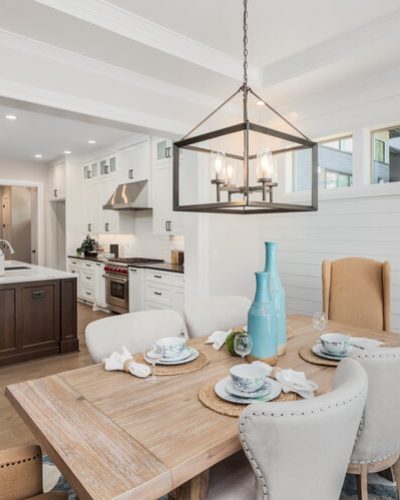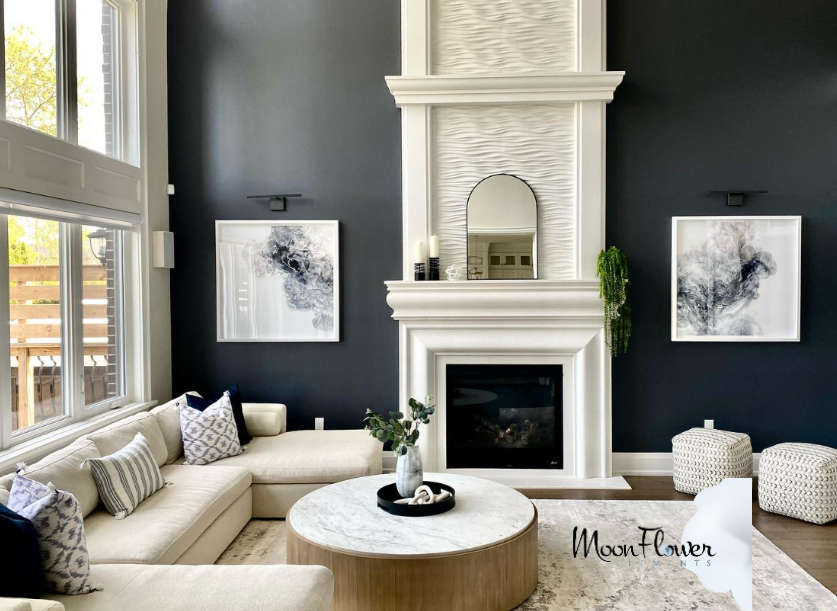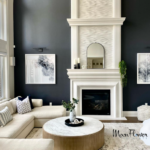Starting Your Decorating Career:
Learning how to Decorate
Imagine entering a room where everything feels just right. This delightful sensation is the result of skilled interior decorating. Creating such an environment doesn’t require innate talent or advanced art degrees. In fact, with the right approach and some passion, anyone can learn the art of interior decorating.
This article discusses the process of learning interior decorating. It involves more than just beautifying spaces; it’s an expression of personal style and a means to enhance well-being. Whether you’re aiming to rejuvenate your own home or contemplating a career in this field, we provide the stepping stones to begin your journey.
The Importance of Learning Interior Decorating
Learning interior decorating allows you to channel your creativity into designing rooms that tell your story. This not only improves aesthetics but also enhances mental well-being, as research has shown that a well-organized and aesthetically pleasing environment can have a positive impact on mood and stress levels. In addition to personal satisfaction, your skills in interior decorating can benefit others. By understanding different styles and elements of design, you can help clients or friends realize their vision for their spaces, translating their ideas and preferences into tangible, enjoyable environments.
Furthermore, when you learn how to decorate, you become a resource for people seeking to bring their visions to life, especially those who may feel overwhelmed by the vast array of design choices or unsure how to achieve a cohesive look. Your expertise can guide them through the selection of colors, furniture, and accessories, creating spaces that reflect their personality and meet their functional needs.
The demand for skilled decorators in various jobs is on the rise. This is due to an increasing appreciation for well-designed spaces, both in residential and commercial settings. As a skilled decorator, you have the potential to embark on a versatile career path. Freelancing offers the freedom to work on diverse projects and build a personal brand, while roles within larger decorating companies provide opportunities for collaboration and working on larger-scale projects. These roles often require not only a good eye for design but also skills in client communication, project management, and staying up-to-date with current trends and materials. This makes the field both challenging and rewarding.
Starting Steps in Decorating
The initial step in mastering interior decorating indeed starts with self-education, focusing on the basic principles of design such as balance, harmony, emphasis, rhythm, proportion, and scale. Understanding these concepts is vital for creating spaces that are both aesthetically pleasing and functional.
Exploring various styles, from modern minimalism to boho chic or mid-century modern, is part of this learning journey. Each style possesses unique characteristics, and familiarizing yourself with these can help in discovering your personal design preferences. Resources like House & Home, Style at Home, Property Brothers and more offer valuable insights into different design styles, broadening your scope of inspiration.
While self-guided learning provides a foundation, certification courses in interior decorating take this knowledge to a more advanced level. These structured courses offer in-depth exploration of design principles and styles. They provide a more comprehensive understanding than what one might obtain from individual research. We’ll explore this later in the article.
Explore the Latest in Interior Decorating through Books
Books are fantastic learning tools. They offer deep insights into color theory, spatial planning, and other fundamental aspects of decorating. Here are some books to check out:
1. Homebody: A Guide to Creating Spaces You Never Want to Leave by Joanna Gaines
- This book offers practical steps for navigating the design process, even if you’re not starting from scratch.
2. Kelly Wearstler: Evocative Style by Kelly Wearstler
- An insight into Wearstler’s glamorous and dynamic interiors, offering inspiration for bold, innovative designs.
3. Rebecca Atwood: Living with Pattern: Color, Texture, and Print at Home by Rebecca Atwood
- Atwood provides practical advice for layering patterns and textures in home designs.
4. Elements of Family Style: Elegant Spaces for Everyday Life by Erin Gates
- This book focuses on creating stylish and functional spaces, particularly for those with families.
5. Architectural Digest at 100: A Century of Style by Architectural Digest
- This book, while celebrating the 100th anniversary of Architectural Digest, showcases the best of interior design, architecture, and art.
6. The New Southern Style: The Interiors of a Lifestyle and Design Movement by Alyssa Rosenheck
- Rosenheck explores a fresh take on Southern aesthetics in interior design, blending traditional elements with contemporary style.
7. Made for Living: Collected Interiors for All Sorts of Styles by Amber Lewis
- Although originally published earlier, the paperback version released in 2022 offers Amber Lewis’s approach to creating inviting and functional spaces.
Trial and Error
Start small – maybe rearrange your living room or give your bedroom wall a fresh coat of paint in a color you’ve been eyeing recently. Practical application will solidify theoretical knowledge while helping uncover personal style preferences.
A Little Help From Friends
Lend a hand with friends’ home projects when possible; practical experience helps build confidence in decision-making abilities while honing skills through real-life challenges that textbooks might not cover.

Online Courses for Interior Decorating
If you’ve ever spent hours scrolling through Pinterest or Instagram, mesmerized by beautifully decorated rooms and thought, “I want to do that,” then online courses in interior decorating might be just what you need. Online courses offer a convenient and flexible way of studying at one’s own pace.
For example, Ultimate Academy®’s Decorating & ReDesign course covers the following topics in interior decorating. This list is not exhaustive:
- Principles and Elements of Design
- Colour Theory
- Interior Design Styles
- The History of Decorating
- Facilitating Consultations
- Flooring
- Furniture
- Lighting
- Accessories
Certification Benefits in Interior Decorating
Gaining a certification in decorating opens doors and provides access to an array of specialized tools and materials that can help stimulate creativity, facilitate projects professionally and effectively, and assist in starting and running a decorating business. Certification courses give creativity a much-needed boost and keep you updated with industry trends.
A certification also increases credibility among clients and peers alike, similar to how renowned brands carry more weight than unknown ones. Clients are more likely to trust someone who has invested in professional development.
Moreover, many employers require certified professionals for their teams due to regulatory requirements or company policies, so becoming certified could lead to more job opportunities.
Lastly, depending on the certification course you enroll in, you gain access to a support team. For instance, Ultimate Academy® offers post-course support, so if you have a question on how to communicate with a tough client or need advice on how to decorate a room, Ultimate Academy® is there to provide guidance.
Maintaining Motivation in Online Learning
Keeping your drive alive while learning decorating online is important and doable! Here are some tips to stay motivated:
Create a Study Schedule
To avoid feeling overwhelmed or losing track of progress, make sure you have a study schedule. But remember, this isn’t about cramming everything into one day; it’s more about consistency and regular practice.
Set Achievable Goals
Setting SMART goals is another proven way to maintain motivation. These should be Specific, Measurable, Attainable, Relevant and Time-bound goals related to your course work which will help guide your journey through interior design training.
Reward Yourself Regularly
Treat yourself after hitting each milestone. It could be anything – an extra hour of TV time or even some ice cream. Little rewards along the way not only celebrate achievements but also boost motivation levels for future tasks.
Stay Connected with Others
A sense of community helps too. Try joining groups related to interior decorating. Sharing experiences and asking questions will give you new perspectives on how others are dealing with similar challenges.
No Prior Design Background Required
Starting a career in interior decorating might seem intimidating if you don’t have a design background. No prior design experience is necessary–that’s the great news. Interior decorating is about expressing your creativity and developing an eye for detail.
A career in decorating isn’t limited to those with formal education or previous experience in design. Many successful decorators started from scratch, just like you.
You may question, “How can I become competent without prior knowledge?” Online courses are the answer. They give comprehensive instruction that allows anyone with passion to learn this art form.
The Ultimate Academy®, offers courses designed for both beginners and those with years of experience. It doesn’t matter where you’re starting from; these programs let learners grow at their own pace while providing expert guidance every step of the way.
This approach promotes inclusivity by opening doors for people who never thought they could enter this field due to lack of traditional training. Remember, it’s not just about what you know at the start, but how much you’re willing to learn and apply along the way.
FAQs in Relation to Learning Interior Decorating
The journey to learn interior decorating can start with self-study, where you dive into design principles, colour theory, and spatial arrangements through design magazines, books, and blogs.
For a more structured approach, certification programs from various institutions cover in-depth aspects of design, colour, textiles, and space planning. Gaining practical experience by experimenting with your own living space, like rearranging furniture, experimenting with colour palettes, and adding decorative elements, is invaluable for hands-on learning.
For beginners in interior decorating, it’s advisable to start with one room to avoid feeling overwhelmed. This process involves learning about colour theory to create a desired mood, understanding the principles of balance and proportion in furniture placement, and experimenting with lighting to affect the room’s ambiance. Additionally, incorporating decorative elements like artwork, rugs, and cushions that complement the color scheme adds character to the space.
The distinction between interior designers and decorators primarily centers around education and specific areas of expertise. Interior designers generally require formal education, often a degree, which equips them with a comprehensive understanding of building codes, structural considerations, and spatial concepts. This education is essential for those who plan to work on projects that involve structural changes or in-depth knowledge of building regulations.
On the other hand, interior decorators, who concentrate more on the aesthetics of a space, like color schemes, furniture, and decorations, typically do not require formal education. However, obtaining certification in interior decorating is highly encouraged for a couple of key reasons:
- Credibility with Clients: Certification can significantly enhance a decorator’s credibility. Clients often feel more confident entrusting their spaces to a certified professional, as it demonstrates a commitment to the field and a certain level of expertise and professionalism.
- Knowledge and Skills: While formal education might not be necessary, a certification program can provide decorators with a structured understanding of design principles, trends, and techniques. This knowledge can be pivotal in creating cohesive, aesthetically pleasing spaces that meet clients’ needs and expectations.
Therefore, while formal education is not a prerequisite for becoming an interior decorator, pursuing certification can be a valuable step towards establishing oneself as a knowledgeable and credible professional in the field.
With dedication, anyone can learn the basics of interior design through books, online courses, and practical application in their own space. However, pursuing certification or a degree can enhance credibility and is particularly beneficial for those considering a professional career in design.
To start an interior decor business, building a strong portfolio by working on projects (including personal or friends’ homes) is crucial. Networking with industry professionals, suppliers, and potential clients is vital.
Establishing a strong online presence through a website and social media, particularly with before-and-after photos, can be very effective. Additionally, understanding the business aspects, such as pricing, contracts, and client management, is essential for success. You can learn the business aspects through certification programs.
The interior design industry in Canada is robust and shows promising growth. As of 2019, 45% of the specialized design service sales in the country came from interior design, indicating a strong demand for professionals in this field.
Furthermore, there were 7,486 interior design establishments in Canada in 2019, with an impressive employment rate of 99.9% in the industry.
This data suggests a vibrant market for aspiring interior decorators and designers, offering numerous opportunities for career growth and development. (Statistics Canada)
Conclusion
The journey into decorating is an exciting and fulfilling one, rich with opportunities for creative expression and personal growth. Remember, your journey in decorating is not just about beautifying spaces, but also about enhancing lives, including your own.
So, pick up that design magazine, enroll in that online course, or rearrange your living room — your journey into the world of decorating begins with that first step. Embrace this opportunity to unleash your creativity and make your mark in the world of design. Start today!











